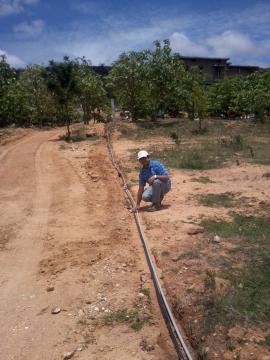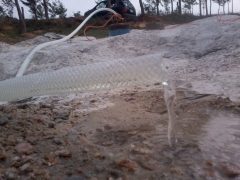



.jpg)
.jpg)
.jpg)
.jpg)
.jpg)
.jpg)
Last to last friday (24th May 2013), we installed the cute looking Shurflo dc pump which we had got from US through Prakash’s friend. The pump was placed at around 130 feet below ground level.
– pump is hanging on two thin clamps placed at the top of the borewell cap. It’s hanging there through a 6 mm nylon rope (what’s typically used for drying clothes).
– We have a half inch transparent flexi pipe connected to the pump. This is the pipe which you would normally see used in gardens and for washing cars.
– We have one feet deep trench dug from borewell point to unit1. The trench had to take a curvy path, thanks to the shape of our land and the rocks. From the top, it would look like a long, thin, starving annaconda. The length of our annaconda is 540 feet.
Later, it was essentially fixing the leaks in all the pipe joints which me and Ratnesh took our sweet time and finally managed to finish. At the end, it looked like a magic that the small pump continued to pump water all the way up through that 540 feet piping even if it got little sunlight and all this WITHOUT ANY EXTERNAL ELECTRICITY. We measured the rate of pumping. It came to around 21 seconds per litre. This meant, even if it remained this cloudy the whole day, it would pump around 1400 litres in one day. We are estimating that on a sunny day, it would easily pump around 3000 litres per day and all this, with just ONE SOLAR panel of 150w and a 0.5 hp pump (usually, 3-5 hp pumps are used for pumping water out of borewells).
Personally, I am finding this extremely exciting because it looks like an easily replicable model. this rate of pumping may serve even the agricultural needs of a farmer and that too, with just surface water – you don’t need those big sources of water since the pump is not demanding a high rate of water inflow. A small 0.5 inch water source (which is very probable at 100-150 ft), is sufficient. Note that the pumping would go on for whole day – 8 am to 4 pm. One can choose to dig multiple of these 100-150 ft wells and of course, the digging cost would also be low. Because you can’t pump at very high rate, you can’t waste water even if you want – drip irrigation integrated in pumping.